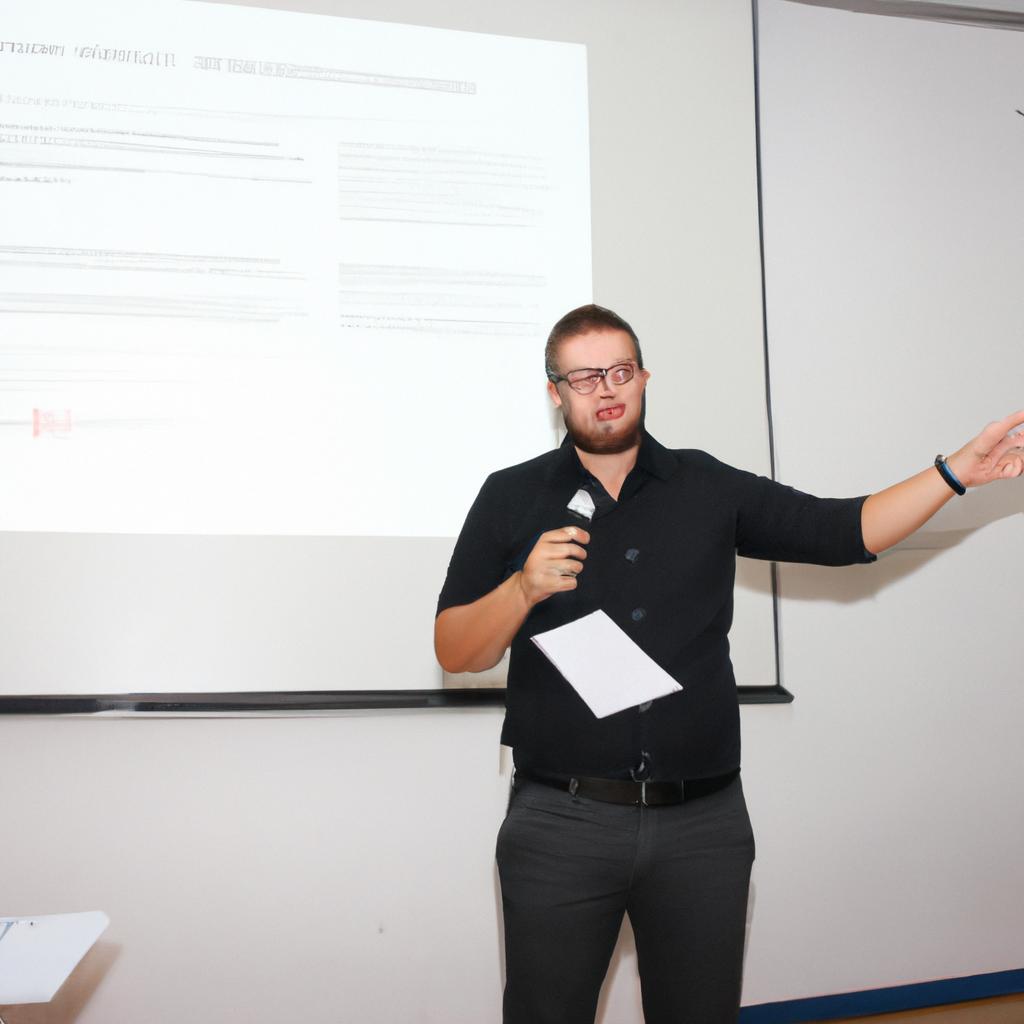In the realm of criminal justice, the fields of penology and criminology play vital roles in understanding and addressing criminal behavior. Both disciplines heavily rely on empirical research and theoretical frameworks provided by social sciences organizations to shed light on the complex nature of crime, criminals, and their interactions with society. This article explores the significant role that social sciences organizations play in shaping the study of penology and criminology.
To illustrate this point, let us consider a hypothetical case study involving two individuals convicted of similar crimes but sentenced under different penal systems. The first individual receives a lengthy prison sentence without any rehabilitative programs or support services, while the second individual is placed in an alternative program focused on rehabilitation and reintegration into society. By analyzing such contrasting outcomes through a multidisciplinary lens, social sciences organizations can offer valuable insights into how various factors influence recidivism rates and overall public safety.
Given the dynamic nature of criminal behavior and societal responses, it becomes imperative for researchers, policymakers, and practitioners within penology and criminology to collaborate closely with social sciences organizations. Through this collaboration, rigorous methodologies can be employed to gather data about offenders’ backgrounds, motivations, and experiences both during incarceration and post-release. Such evidence-based practices allow for informed decision-making and the implementation of effective policies and interventions.
Social sciences organizations provide a wealth of knowledge and expertise in research methodologies, data analysis, and theoretical frameworks. They can assist in designing studies that capture comprehensive information on various aspects of criminal behavior, such as the root causes, psychological factors, social influences, and environmental conditions. By collecting and analyzing this data, researchers can identify patterns and trends that contribute to criminal behavior and inform evidence-based strategies for prevention, intervention, and rehabilitation.
Furthermore, social sciences organizations play a crucial role in evaluating the effectiveness of different penal systems and programs aimed at reducing recidivism rates. Through rigorous evaluation methods, they can assess the impact of specific interventions or policies on offenders’ outcomes, such as their likelihood of reoffending or successful reintegration into society. This evaluation helps policymakers make informed decisions about resource allocation and program improvements to maximize public safety while also promoting offender rehabilitation.
Additionally, social sciences organizations facilitate collaboration between academia, practitioners, policymakers, and other stakeholders within the field of criminal justice. By bringing together experts from different disciplines and sectors, they foster an exchange of ideas and promote interdisciplinary approaches to understanding and addressing crime. This collaboration ensures that the knowledge generated through research is effectively translated into policy recommendations and practical applications.
In conclusion, social sciences organizations play a significant role in shaping the study of penology and criminology by providing empirical research findings, theoretical frameworks, rigorous methodologies, evaluation capabilities, and fostering collaboration among stakeholders. Their contributions are essential for advancing our understanding of criminal behavior and developing evidence-based strategies to prevent crime, rehabilitate offenders effectively, ensure public safety, and promote justice in society.
Understanding Penology
Penology is a branch of criminology that focuses on the study of punishment and rehabilitation methods within the criminal justice system. It involves understanding the theories behind why people commit crimes, as well as assessing the effectiveness of various correctional strategies. To illustrate this concept, consider the case of John, who was convicted for burglary. By examining his behavior and motivations, penologists can gain valuable insights into how to prevent similar crimes in the future.
One key aspect in understanding penology is recognizing the multiple factors that contribute to criminal behavior. These can include socio-economic status, psychological disorders, or even peer pressure. For instance, studies have shown that individuals from disadvantaged backgrounds are more likely to engage in criminal activities due to limited opportunities for education and employment. This highlights the importance of considering societal inequalities when formulating effective penal policies.
To further emphasize this point, let us explore some emotional responses associated with different penalty systems:
- Retribution: Involves punishing offenders solely based on their actions without considering any underlying causes or potential for reform.
- Deterrence: Aims to discourage others from committing crimes by imposing severe penalties on offenders.
- Rehabilitation: Focuses on providing rehabilitative programs aimed at addressing the root causes of criminal behavior and reintegrating offenders back into society.
- Restorative Justice: Emphasizes repairing harm caused by crime through dialogue between victims, offenders, and communities.
The following table provides a comparative analysis of these approaches:
| Penalty System | Goals | Emotional Response |
|---|---|---|
| Retribution | Accountability | Anger |
| Deterrence | Fear | Anxiety |
| Rehabilitation | Transformation | Hope |
| Restorative Justice | Healing | Empathy |
Understanding these diverse perspectives allows policymakers and practitioners to develop comprehensive interventions tailored to individual circumstances while being mindful of the broader societal impact. By adopting a multidisciplinary approach that draws on insights from psychology, sociology, and other social sciences, penologists can better comprehend the complex dynamics at play within the criminal justice system.
Transitioning to the subsequent section about “The Importance of Social Sciences in Penology,” it becomes evident that studying these disciplines is crucial for formulating effective penal policies and promoting a fairer and more just society.
The Importance of Social Sciences in Penology
Understanding Penology lays the foundation for comprehending the significance of social sciences in this field. Social science organizations play a crucial role in penology as they contribute to the understanding, prevention, and rehabilitation of criminal behavior. By employing scientific methods and research techniques, these organizations seek to address the complex issues surrounding crime and its consequences.
To illustrate the importance of social sciences in penology, let us consider a hypothetical case study: John is an individual who has been incarcerated multiple times due to his involvement in drug-related offenses. Traditional approaches to punishment have failed to effectively address his underlying issues such as addiction and lack of education. However, with the application of social sciences principles by relevant organizations, alternative strategies can be developed that focus on rehabilitation rather than solely punitive measures.
The significance of social sciences in penology can be further understood through their impact in four key areas:
- Risk assessment: Social science organizations employ various tools and methodologies to assess the risk factors associated with criminal behavior. This enables them to identify individuals who are more likely to reoffend and develop targeted intervention programs to reduce recidivism rates.
- Program evaluation: Through rigorous research methods, social science organizations evaluate existing correctional programs to determine their effectiveness. This allows for evidence-based decision making regarding which interventions should be implemented or modified.
- Policy development: By conducting comprehensive studies and analyzing statistical data, social science organizations inform policy makers about best practices in penological approaches. These insights guide the development of policies that align with societal goals while ensuring public safety.
- Community engagement: Social science organizations foster collaboration between criminal justice systems and local communities. They facilitate dialogue among stakeholders, encouraging community participation in designing effective crime prevention initiatives.
Furthermore, it is important to acknowledge that social sciences’ contribution extends beyond theoretical frameworks and empirical analysis alone. To better grasp the multifaceted nature of their work, consider the following table:
| Contributions of Social Sciences Organizations |
|---|
| Conduct research and analysis |
| Develop evidence-based interventions |
| Promote community engagement |
| Inform policy development |
In conclusion, the integration of social sciences in penology serves as a catalyst for positive change within criminal justice systems. By understanding the complexities of crime and adopting evidence-based approaches, social science organizations contribute to the prevention of criminal behavior and the rehabilitation of offenders. In the subsequent section, we will explore the role of penology in criminal justice, building upon the foundation established by our discussion on social sciences.
Exploring the Role of Penology in Criminal Justice
Section Title: The Impact of Social Sciences in Penology
Transitioning from the previous section, where we discussed the importance of social sciences in penology, it becomes evident that these disciplines play a crucial role in shaping criminal justice systems. By employing various methodologies and theories, social sciences organizations contribute to our understanding of crime and its prevention.
To illustrate this impact, let us consider a hypothetical case study involving an individual named Alex. Through the lens of social sciences, professionals can analyze factors such as upbringing, socioeconomic status, and peer influence to gain insights into why Alex turned to criminal behavior. This holistic approach allows for a more comprehensive understanding of crime causation rather than simplistic attributions solely based on personal choices.
Social sciences organizations make significant contributions to penology by providing evidence-based research and analysis. Here are some key ways they shape our understanding:
- Criminological Research: Researchers within social sciences organizations conduct studies on various aspects of crime and punishment. These empirical investigations help identify patterns, risk factors, and effective interventions.
- Policy Development: Social scientists collaborate with policymakers to develop informed strategies aimed at reducing recidivism rates and improving rehabilitation efforts. Their expertise ensures policies are rooted in sound scientific knowledge.
- Program Evaluation: Through rigorous evaluation methods, social sciences organizations assess the effectiveness of correctional programs and initiatives. This data-driven approach helps determine which interventions yield positive outcomes for individuals within the criminal justice system.
- Community Engagement: Social sciences organizations promote community involvement through educational outreach programs designed to raise awareness about crime prevention strategies. They work hand-in-hand with local communities to foster trust between law enforcement agencies and residents.
This table summarizes how different branches of social sciences contribute towards enhancing penological practices:
| Branch | Contribution |
|---|---|
| Sociology | Examines societal influences on criminal behaviors |
| Psychology | Studies mental health implications related to criminality |
| Criminology | Analyzes crime patterns and prevention strategies |
| Anthropology | Explores cultural factors influencing criminal behaviors |
In conclusion, social sciences organizations play a vital role in shaping penological practices. By understanding the complex interplay of individual and societal factors that contribute to criminal behavior, these disciplines provide valuable insights for developing effective policies and programs within the criminal justice system.
Transitioning into the subsequent section about “Rehabilitation Programs: A Social Sciences Perspective,” it is important to note how social sciences can inform our approach to offender rehabilitation rather than viewing it as just another step in the criminal justice process.
Rehabilitation Programs: A Social Sciences Perspective
Transitioning from the exploration of penology’s role in criminal justice, we now delve into how social sciences organizations contribute to this field. By analyzing various aspects related to crime and punishment through a sociological lens, these organizations provide invaluable insights that aid in understanding the complexities of the criminal justice system.
To illustrate their impact, consider a hypothetical case study where a social sciences organization conducts research on recidivism rates among individuals who have undergone rehabilitation programs. Through their findings, they identify key factors contributing to successful reintegration into society and reducing repeat offenses. This example showcases the practical application of social sciences organizations’ contributions towards evidence-based policies aimed at lowering crime rates.
The involvement of social sciences organizations in penology and criminology can be further understood by examining four key areas:
-
Research: These organizations conduct rigorous studies on various topics such as offender behavior, societal influences on crime rates, and the efficacy of different correctional methods. Their research provides crucial data for policymakers, allowing them to make informed decisions regarding law enforcement practices and sentencing guidelines.
-
Policy Development: Based on their extensive research, these organizations actively participate in policy development discussions at local, national, and international levels. They advocate for evidence-based approaches that prioritize prevention strategies, restorative justice initiatives, and community integration efforts over punitive measures alone.
-
Collaboration: Social science organizations collaborate with government bodies, academic institutions, non-profit agencies, and community stakeholders to address complex issues surrounding penology and criminology. By bringing together diverse perspectives and expertise, they foster interdisciplinary dialogue essential for comprehensive problem-solving.
-
Education and Training: These organizations play a vital role in educating future professionals within the field of criminal justice by providing specialized training programs tailored to practitioners’ needs. Such initiatives enhance knowledge transfer between academia and practice while promoting best practices rooted in empirical evidence.
| Key Areas of Contribution | Description |
|---|---|
| Research | Conducting studies on offender behavior, crime rates, and correctional methods |
| Policy Development | Participating in policy discussions to advocate for evidence-based approaches |
| Collaboration | Collaborating with various stakeholders to address complex issues |
| Education and Training | Providing specialized training programs for professionals within the field |
In summary, social sciences organizations play a pivotal role in penology and criminology by conducting research, contributing to policy development, fostering collaboration among stakeholders, and providing education and training. Through their efforts, they contribute valuable insights that inform evidence-based practices aimed at creating an effective criminal justice system.
As we have explored the contributions of social sciences organizations in penology and criminology, it becomes evident that understanding the sociology of crime and punishment is crucial.
The Sociology of Crime and Punishment
The efficacy of rehabilitation programs in reducing recidivism rates has long been a topic of interest within the field of criminology. One real-life example that highlights the potential benefits of such programs is the case study of John, a young offender who was convicted for armed robbery at the age of 18. Through his involvement in a comprehensive rehabilitation program that combined cognitive-behavioral therapy, vocational training, and social support, John successfully reintegrated into society upon his release from prison.
In examining the role of social sciences organizations in designing effective rehabilitation programs, several key factors emerge:
-
Individualized Treatment Plans: Recognizing that each offender possesses unique needs and circumstances, successful rehabilitation programs prioritize individualized treatment plans. This involves conducting thorough assessments to identify underlying issues such as substance abuse or mental health disorders and tailoring interventions accordingly.
-
Holistic Approach: Effective rehabilitation acknowledges that crime often stems from complex socio-economic factors. Thus, these programs adopt a holistic approach by addressing not only criminal behavior but also associated challenges like unemployment, lack of education, or inadequate housing. By providing individuals with tools to overcome these obstacles, they aim to reduce their likelihood of reoffending.
-
Community Reintegration: Rehabilitation efforts extend beyond confinement and encompass successful community reintegration post-release. Social sciences organizations play a crucial role in facilitating this process by establishing partnerships with local businesses and community resources to secure employment opportunities and stable housing for ex-offenders.
-
Long-term Support Systems: To ensure sustained positive outcomes, rehabilitation programs emphasize ongoing support systems for offenders even after completing their sentences. This may include regular counseling sessions or mentorship programs aimed at assisting individuals in navigating societal pressures while maintaining pro-social behaviors.
Table 1 below illustrates some commonly used components in an effective rehabilitation program:
| Component | Description |
|---|---|
| Cognitive-Behavioral | Focused on identifying and addressing distorted thinking patterns that contribute to criminal behavior |
| Therapy | |
| Vocational Training | Equipping offenders with marketable skills to enhance employment prospects |
| Social Support | Building a network of positive relationships to foster community reintegration |
Through the implementation of these strategies, social sciences organizations endeavor to reduce recidivism rates and promote successful rehabilitation outcomes. By recognizing the multifaceted nature of crime and adopting evidence-based approaches, they strive to provide individuals like John with opportunities for personal growth and societal reintegration.
Transitioning into the subsequent section about “Psychological Approaches to Penology,” it is imperative to delve further into the understanding of offender psychology in order to develop more effective interventions.
Psychological Approaches to Penology
Building upon the sociological perspective of crime and punishment, this section delves into psychological approaches to penology. Understanding how individuals’ thoughts, emotions, and behaviors contribute to criminal behavior is crucial in formulating effective strategies for rehabilitation and reintegration.
Psychological perspectives on penology emphasize the role of individual factors in shaping criminal actions. For instance, consider a hypothetical case study involving an individual named Alex who has a history of substance abuse and frequent encounters with law enforcement due to theft offenses. A psychological approach would examine underlying factors such as addictive tendencies, impulse control issues, and past trauma that may have contributed to Alex’s engagement in criminal activities.
To better comprehend the complexities involved in addressing these psychological aspects within penology, it is important to highlight several key considerations:
- Individualized Treatment: Recognizing that each person possesses unique experiences and needs, tailoring intervention programs based on individual assessment can lead to more successful outcomes.
- Cognitive-Behavioral Therapy (CBT): This evidence-based therapeutic approach focuses on identifying and modifying negative thought patterns and behaviors associated with crime. By targeting cognitive distortions and enhancing problem-solving skills, CBT aims to reduce recidivism rates.
- Substance Abuse Treatment: Given the significant correlation between substance abuse and criminal behavior, incorporating comprehensive treatment programs within correctional facilities can address underlying addiction issues while reducing the likelihood of relapse post-release.
- Mental Health Support: Providing access to mental health services during incarceration is vital as many individuals enter the system with undiagnosed or untreated conditions. Addressing these issues through counseling and medication management can promote long-term well-being.
Embracing a holistic understanding of penology necessitates integrating various disciplines such as sociology, psychology, criminology, and social work. These interdisciplinary collaborations enable organizations working in the field of social sciences to develop innovative solutions aimed at reducing crime rates while fostering rehabilitation efforts among offenders.
Table example:
| Psychological Approaches to Penology |
|---|
| Individualized Treatment |
| Cognitive-Behavioral Therapy (CBT) |
| Substance Abuse Treatment |
| Mental Health Support |
The table above summarizes important psychological approaches used in penology, highlighting the key strategies employed to address individual needs and reduce recidivism rates.
In summary, by focusing on psychological perspectives within penology, we gain valuable insights into the intricate factors that contribute to criminal behavior. Recognizing the importance of individual differences and implementing evidence-based interventions can guide efforts towards successful rehabilitation and reintegration of offenders back into society. Through interdisciplinary collaboration and comprehensive support systems, social sciences organizations play a pivotal role in shaping more effective practices within the field of penology.




